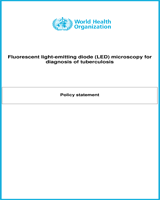Overview
Light-emitting diodes (LED) have been developed to offer the benefits of fluorescence microscopy without the associated costs. In 2009, the evidence for the efficacy of LED microscopy was assessed by the World Health Organization, on the basis of standards appropriate for evaluating both the accuracy and the effect of new TB diagnostics on patients and public health.
The results showed that the accuracy of LED microscopy was equivalent to that of international reference standards, it was more sensitive than conventional Ziehl-Neelsen microscopy and it had qualitative, operational and cost advantages over both conventional fluorescence and Ziehl-Neelsen microscopy.
On the basis of these findings, WHO recommends that conventional fluorescence microscopy be replaced by LED microscopy, and that LED microscopy be phased in as an alternative for conventional Ziehl-Neelsen light microscopy.
The designations employed and the presentation of the material in this publication do not imply the expression of any opinion whatsoever on the part of the World Health Organization concerning the legal status of any country, territory, city or area or of its authorities, or concerning the delimitation of its frontiers or boundaries. Dotted lines on maps represent approximate border lines for which there may not yet be full agreement.
The mention of specific companies or of certain manufacturers’ products does not imply that they are endorsed or recommended by the World Health Organization in preference to others of a similar nature that are not mentioned. Errors and omissions excepted, the names of proprietary products are distinguished by initial capital letters.
All reasonable precautions have been taken by the World Health Organization to verify the information contained in this publication. However, the published material is being distributed without warranty of any kind, either expressed or implied. The responsibility for the interpretation and use of the material lies with the reader. In no event shall the World Health Organization be liable for damages arising from its use.

